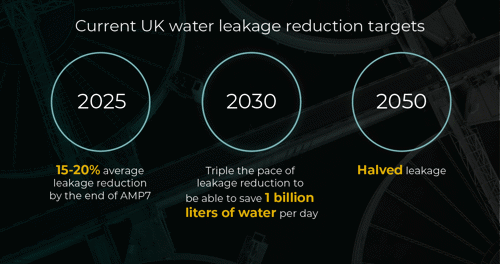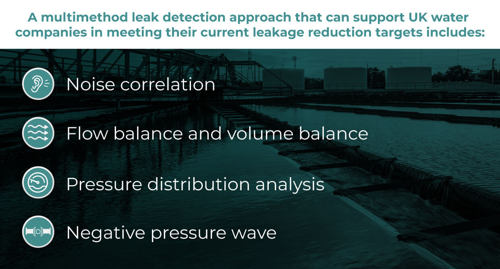Troubled waters: the current state of UK water leakage
According to Ofwat, over 20% of all UK water running through pipes is lost to leakage,1 presenting leakage as a sizable threat to the UK water and wastewater industries.
Stringent deadlines have now been set by regulators like Ofwat, which has resulted in accelerated efforts by water utilities to achieve these targets.
While some of these targets are decades away, some deadlines are as early as 2025. With the pressure on for UK water companies to reduce the amount of water they lose each year, this article considers:
- The history of UK water leakage
- Current targets for reducing water leakage
- The challenges of implementing water leak detection
- A multimethod approach to water leakage reduction
A history of UK water leakage
Leakage reduction has been a high priority for the UK water and wastewater sectors since before the 21st century. In 1997, leakage reduction became a regulatory requirement in England and Wales after the region experienced significant droughts in 1995 which left reservoir levels low. This attention towards leakage reduction has only increased with time, too.
The Water Services Regulation Authority (Ofwat) is responsible for the economic regulation of the privatized water and sewerage industry in England and Wales and they consistently set performance commitments in five-year planning cycles called asset management plan (AMP) periods. Current targets set by Ofwat in AMP7 (covering period 2020-2025) require water utilities to drive environmental investigation, protection and change.2 This means that leakage reduction has been at the top of UK water utilities’ agendas for the past few years.
Current targets

2050
In 2019, water companies in England set themselves the goal of halving leakage by 2050 and tripling the pace of leakage reduction, producing a 2050 Leakage Routemap which outlines an adaptive pathway approach that can be used to meet the leakage targets.
2030
Tripling the pace means they’ll aim to achieve in the current decade (2020-2030) a level of improvement in leakage reduction that had previously taken 30 years to achieve.
2025
The current AMP7 leakage performance commitments expect water utilities to achieve an average of 15-20% leakage reduction by the end of the plan period.
The challenge
There are many challenges facing water leakage reduction improvements in the UK, mainly the fact that a substantial amount of pipelines in the UK could be classified as aging or reaching its wear out failure period.
Some UK water pipelines are more than 100 years old and if left unaddressed an aging water pipeline presents a range of risks:
- Leakage, spills and ruptures
- Impacts on water supply to residential areas
- Damage to high consequence areas eg densely populated locations from flooding
- Hazardous impacts to water quality (the particles created by the corrosion that causes pipelines to age can settle inside a pipeline distribution network)
- Fines and cleanup costs, paid for by the water utility3
According to Water UK, a membership body comprising of UK water companies to represent the interests of the water and wastewater industries, there are nearly 350,000 km of aging water mains across the UK, but this isn’t the only challenge when it comes to leakage reduction.4
The 2050 leakage routemap highlights some of the key challenges facing water utilities as they prioritize leakage reduction as part of their water resource management plans:
- More industry and supply chain support
- Support from regulators and the government
- Improved collaboration with local authorities and highway agencies
- Step-change in the replacement of aging pipelines
These challenges present obstacles in the face of the UK water and wastewater industries’ optimistic leakage reduction targets for 2025, 2030 and 2050, but that doesn’t mean these targets aren’t achievable.
The solution
An accelerated effort from UK water utilities is possible and has the potential to save almost a billion liters of water per day by 2030, putting the UK water and wastewater sectors on track to halving leakage by 2050.

Four leak detection methods can provide support to UK water utilities in meeting their leakage reduction targets:
- Noise correlation
- Flow balance and volume balance
- Pressure distribution analysis
- Negative pressure wave
Noise correlation
Also known as acoustic sensing, noise correlation is an external based leak detection method, which listens for the sound of existing leaks in the pipeline to provide support.
Flow balance and volume balance
Inlet versus outlet flow readings can be measured using flow meters and can detect existing leaks in a water pipeline network as well as new leaks forming over a longer period of time by interrogating discrepancies in the readings.
Pressure distribution analysis
Using multiple pressure sensors across a network, small discrepancies in pressure can be used to identify background leakage.
Negative pressure wave
A new leak forming on a pipeline causes a negative pressure wave to emit just once, propagating in both directions of the pipeline. Atmos solutions like Atmos Wave Flow use sensitive pressure sensors to collect pressure readings which are then processed to identify leak location and leak rate of a new leak.
Supporting you to meet your water leakage reduction targets
The leakage performance commitments seen in AMP7 aren’t the first tight deadlines we’ve seen for the UK water and wastewater industries, nor will they be the last.
It’s never been as important to take a multimethod approach to water leakage reduction, which is why Atmos prioritizes a multimethod approach that considers noise correlation, intelligent flow balance, pressure distribution analysis and negative pressure wave processing.
Since 1995 we have been addressing the challenges faced by the oil, gas and chemical industries, with our technology being successfully applied to over 1,500 pipelines across more than 60 countries. This experience has driven our innovation to help the water industry meet the ambitious performance commitments that it faces.
Atmos’ research and development team continuously innovate for a better performance and reducing deployment costs to make it possible for every water and wastewater pipeline to have the best integrity monitoring tools.
As the world’s leading leak detection provider, we are best placed to help you ensure any leak is detected reliably and located accurately.
References
1 https://www.ofwat.gov.uk/leakage-in-the-water-industry/
4 https://www.water.org.uk/publication/a-leakage-routemap-to-2050/
